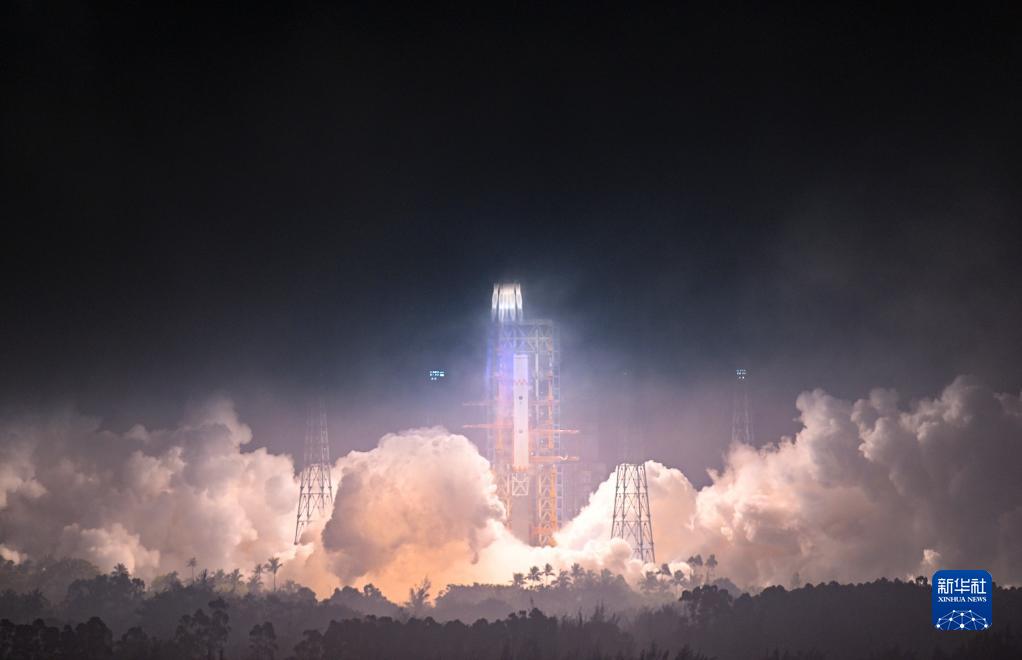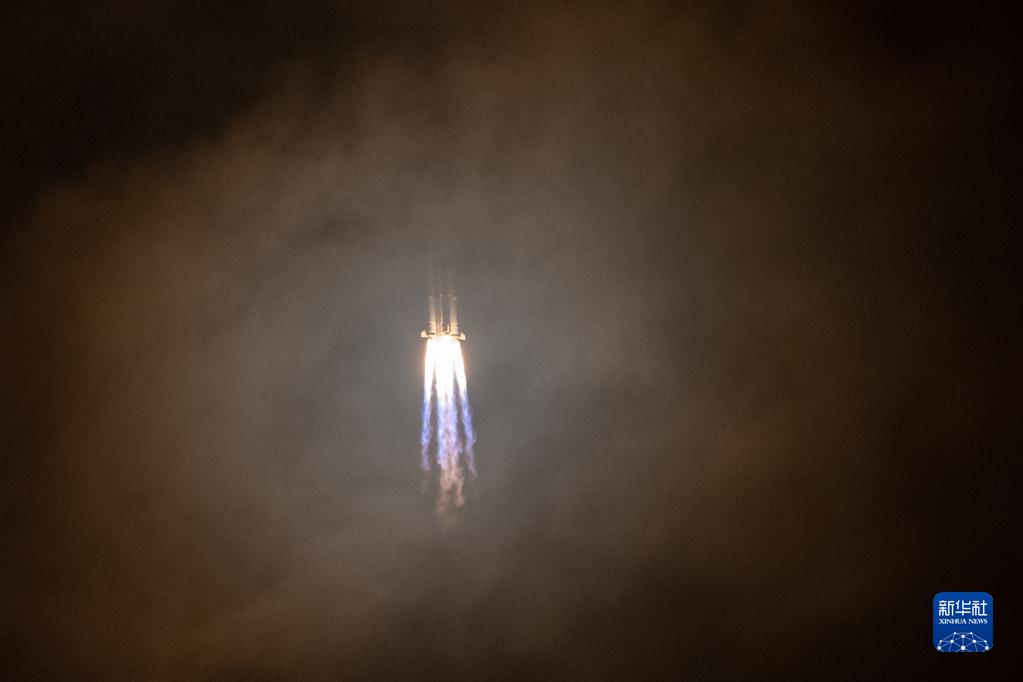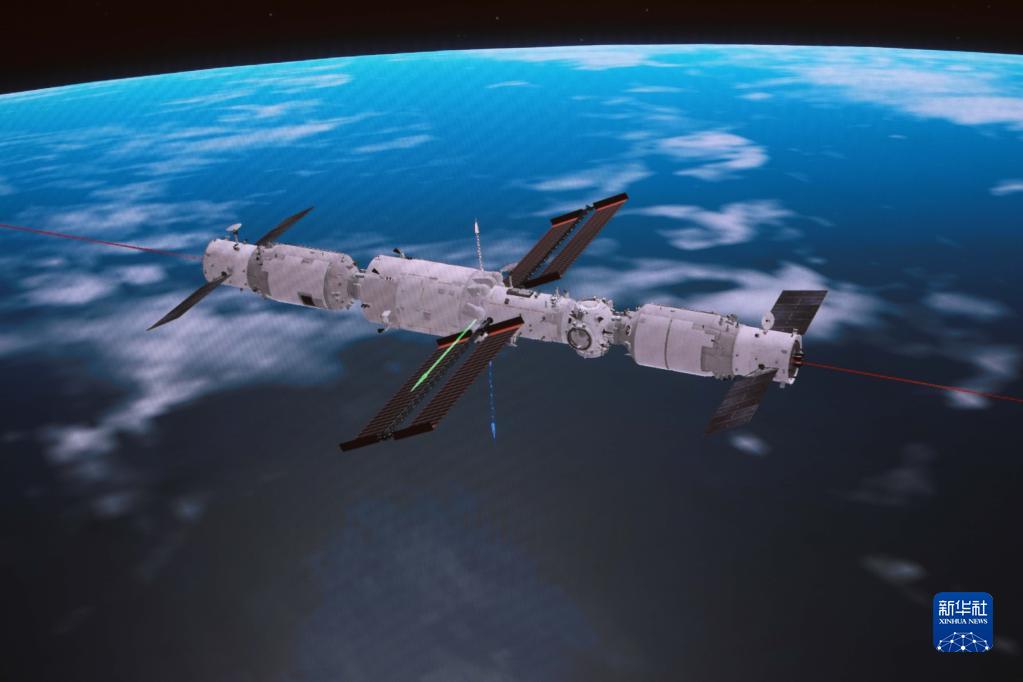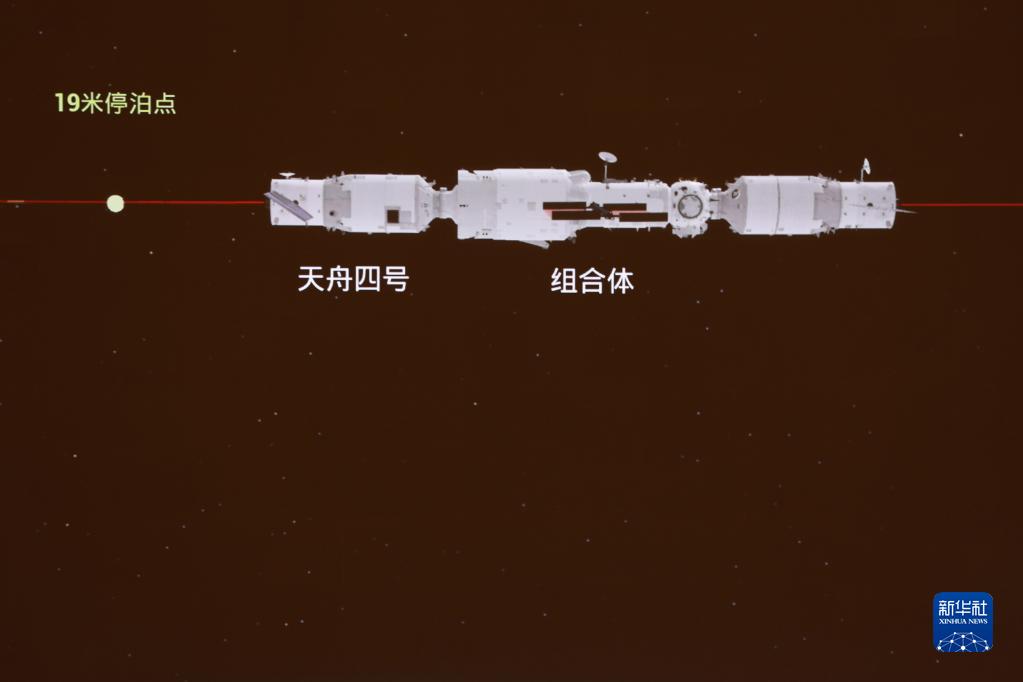Xinhua|
Xinhua News Agency reporters Li Guoli, Sun Luming, Zhang Ruijie, Chen Kaizi
At 1:56 a.m. on May 10, the Tianzhou-4 cargo spacecraft was lifted by the Long March 7 carrier rocket and flew into space from the Wenchang Space Launch Site on the coast of the sea.
This is the fourth cargo spacecraft successfully launched by my country since April 2017, and the third express “package” sent to the Tianhe core module of the space station.
On a good night in a year, Tianzhou will set off again.
The curtain of the construction phase of China’s space station has officially opened, and the key battle to achieve the “three-step” strategic goal of my country’s manned space project has begun.

At 1:56 a.m. on May 10, the Long March 7 carrier rocket lifted the Tianzhou-4 cargo spacecraft into the air. About 10 minutes later, the spacecraft and the rocket successfully separated and entered the predetermined orbit. At 2:23, the spacecraft solar energy The windsurfing board worked smoothly and the launch was a complete success.Photo by Xinhua News Agency reporter Yang Guanyu
Say goodbye to the sea and fly to the sky
In the ancient town of Qiongbei, the summer night is deep.
The Wenchang space launch site on the coast of the coconut forest is brightly lit, and the Tianzhou-4 cargo spacecraft and the Long March-7 carrier rocket are ready to go, pointing to the sky.
“Attention everyone, prepare in 1 hour!”
At 0:56, the command of Wang Yuliang, the commander of the launch mission 01, resounded through the launch site, and the slewing platform of the launch tower slowly opened.
Under the searchlight, the halo of the milky white ship and arrow combination is flowing, and the bright five-star red flag and the six big blue characters of “China Manned Spaceflight” are particularly eye-catching.
This is the first launch in the construction phase of my country’s space station, and it is also the fourth expedition of the space station’s cargo transportation system.
Five years ago, as the final work of the second step of the “three-step” development strategy of my country’s manned spaceflight project, Tianzhou-1 flew into the sky from here and embarked on the journey of chasing the dream of space.
“Attention everyone, prepare in 30 minutes!” At 1:26, Wang Yuliang’s password resounded through the launch site again, and the bunkering personnel began to evacuate to the safe area.
This is the 17th space launch mission after the completion of the Wenchang Space Launch Site, and the fifth time the Long March 7 carrier rocket has been launched.
“As the first mission in the construction phase of the space station, the successful launch of Tianzhou-4 is directly related to the successful completion of subsequent missions,” said Zhong Wenan, chief engineer of the Xichang Satellite Launch Center.

At 1:56 a.m. on May 10, the Long March 7 carrier rocket lifted the Tianzhou-4 cargo spacecraft into the air. About 10 minutes later, the spacecraft and the rocket successfully separated and entered the predetermined orbit. At 2:23, the spacecraft solar energy The windsurfing board worked smoothly and the launch was a complete success.Photo by Xinhua News Agency reporter Guo Cheng
In the past few days, the scientific and technical personnel of the launch site have carefully and meticulously carried out quality control, analyzed and identified stage by stage, project by project, and step by step, and continued to improve various plans and plans to ensure that the launch mission is foolproof.
“Attention everyone, prepare in 15 minutes!” At 1:41, the 01 commander issued the countdown password again.
A year ago, the Tianzhou-2 was loaded with cargo and pierced into the sky from here, to search for the Tianhe core module of the space station, which was not long before it took off. Eight months ago, still in this old place, Tianzhou-3 rushed to the sky and delivered the astronauts’ living supplies, propellants and other goods to the Tianhe core module.
On that day, two cargo spacecraft flew together with the Tianhe core module, setting a new record in the history of China’s manned spaceflight.
“Attention everyone, prepare in 1 minute!” In the voice of the password, the pendulum rod supporting the rocket opened, and the system equipment connected to the rocket on the launch tower fell off automatically.
At this time, the combination of Tianhe core module and Tianzhou-3 of the space station is flying over Wenchang, Hainan at a height of 400 kilometers.
At this moment, everyone on the scene held their breath, and the lively launch site also quieted down, only Wang Yuliang’s password echoed between heaven and earth——
“5, 4, 3, 2, 1, fire!”
At 1:56, the earth-shattering roar resounded through the sea and the sky. The Long March 7 carrier rocket lifted the Tianzhou 4 into the sky, drawing a gorgeous trajectory in the night sky, saying goodbye to the sea and flying towards Tianhe.
The sea has once again witnessed the highlight of China’s aerospace industry.

At 1:56 a.m. on May 10, the Long March 7 carrier rocket lifted the Tianzhou-4 cargo spacecraft into the air. About 10 minutes later, the spacecraft and the rocket successfully separated and entered the predetermined orbit. At 2:23, the spacecraft solar energy The windsurfing board worked smoothly and the launch was a complete success.Photo by Xinhua News Agency reporter Hu Zhixuan
“Express” to, waiting for “sign”
The booster was separated, the fairing was separated, and the ship and arrow were successfully separated… Tianzhou-4 successfully entered space.
At this time, the combination of Tianhe core module and Tianzhou-3 of the space station has been waiting in space for more than 230 days. In order to welcome the first “Visitor from Earth” this year, the “China Palace” has made various preparations——
On April 20, Tianzhou-3 was separated from the rear port of Tianhe core module, flew around and automatically docked to the forward port, “letting sages” for Tianzhou-4’s rear docking.
Earlier on March 31, Tianzhou-2 successfully completed its scheduled mission and re-entered the atmosphere in a controlled manner. Again, this is to free up the rendezvous interface in advance.
The Tianhe core module is equipped with 5 docking ports, of which the rear docking port and the forward docking port are used to dock the cargo spacecraft.
The Tianzhou cargo spacecraft is the ground logistics supply spacecraft of the Chinese space station, and it is also the cargo spacecraft with the largest cargo transportation capacity and the most comprehensive on-orbit support capability in active service.
In order to meet the needs of intensive launches in the construction phase of the space station, Tianzhou cargo spacecraft carried out batch production, and produced Nos. 2, 3, 4, and 5 at the same time, and their shapes and functions are similar or similar.
“Tianzhou-4 is my country’s first spacecraft to enter the construction stage of the space station. It undertakes the tasks of providing material support for the Shenzhou 14 astronauts, space station orbital operation support and space science experiments.” Aerospace Science and Technology Group Fifth Academy Cargo Spacecraft System Deputy Chief Designer Dang Rong said.
This time, Tianzhou-4 has loaded a total of more than 200 pieces (sets) of goods, including packaged goods and direct installation goods, and will provide materials for Shenzhou-14 astronauts to stay in orbit for 6 months, assemble and construct the space station, and carry out materials. Provide material support in space application fields such as science.
“Tianzhou-4 carried about 750 kilograms of additional propellant, which is similar to that of Tianzhou-3, but the total weight of the up-going materials was about 6,000 kilograms, which was 300 kilograms more than that of Tianzhou-3, and the transportation capacity was further improved. “Bai Mingsheng, chief designer of the cargo spaceship system of the Fifth Academy of Aerospace Science and Technology Group, introduced, “This time, there is no extravehicular space suit, because there are already 3 sets on it.”

At 1:56 a.m. on May 10, the Long March 7 carrier rocket lifted the Tianzhou-4 cargo spacecraft into the air. About 10 minutes later, the spacecraft and the rocket successfully separated and entered the predetermined orbit. At 2:23, the spacecraft solar energy The windsurfing board worked smoothly and the launch was a complete success.Photo by Xinhua News Agency reporter Yang Guanyu
In addition, the researchers have continued to improve and optimize the design of Tianzhou-4 based on the opinions of astronauts in orbit.
For example, the color identification of the cargo package has been added to make it more convenient and intuitive for astronauts to find the cargo: the cargo packages of Tianzhou-2 are all of the same color, and the label font is also the same, which is not easy to distinguish. The bags of Tianzhou-3 were tied with ribbons of different colors. Tianzhou-4 is distinguished by color from the identification label.
Compared with Tianzhou-3, Tianzhou-4 has more convenient cargo access. There are cargo compartments in the cargo compartment, and there is a cover on the cargo compartment. The previous design was screwed on with screws. To open and close the cover, you need to twist the screws back and forth, which is quite troublesome to operate in the sky. This time, the technicians used Velcro on the cover and the box. They only need to screw the screw once when opening the cargo compartment for the first time, and the back cover can be opened at any time, which is very convenient. They also optimized the design of the cushioning foam in the package by subdivision and miniaturization, which can reduce the space occupation and facilitate storage and storage.
Now, the space “express” has been delivered, and it is only waiting for Shenzhou to “sign”.
The Chinese space station has entered the construction stage, and astronaut crew rotation and cargo supply will be carried out every six months. This means that after the successful launch of Tianzhou-4, the manned flight mission of Shenzhou-14 has also entered the countdown.
The Jiuquan Satellite Launch Center is also busy during this time, and the scientific and technological personnel are making various preparations for the mission. The Shenzhou 14 astronaut crew has also been selected, and according to the plan, they will hit the sky again next month.
On the banks of the Ruoshui River, we will witness the 9th flight of the Chinese people.

This is a schematic diagram of the autonomous rapid rendezvous and docking of the Tianzhou-4 cargo spacecraft and the space station assembly taken at the Beijing Aerospace Flight Control Center (photographed on May 10).Photo by Xinhua News Agency reporter Guo Zhongzheng
“The courier brother” Lian Zhan Lianjie
The Tianzhou-4 was successfully launched, and the Long March-7 was victorious in consecutive battles, and its performance was still outstanding.
The Long March 7 is my country’s new generation of medium-sized launch vehicles. Since its maiden flight in 2016, it has carried out a total of 4 Tianzhou cargo spacecraft launches, delivering a large amount of materials to the Chinese space station and space laboratory, and is known as the “courier brother” in space.
In order to meet the needs of future space station operations, this time, the research and development team optimized the process before the launch of Long March 7, reducing the measurement and launch cycle by 4 days compared with the launch of Tianzhou 3.
This is the first time that the Long March 7 has completed the test and launch within one month.
“Reducing the test and launch cycle by 4 days is a major process improvement task, which not only challenges the comprehensive performance of the Changqi rocket, but also tests the resilience of the launch team members in a high-intensity working environment. Each sub-system of the rocket must carry out process optimization work at the same time. Only then can we achieve the ultimate goal.” said Meng Gang, the chief commander of the Long March 7 launch vehicle of the Aerospace Science and Technology Group.
The restoration of ground equipment is the first work of the Long March 7’s approach, and it is also a prerequisite for rocket testing. This alone saves 2.5 days of time.

This is the Tianzhou-4 cargo spacecraft and the space station assembly completed autonomous rapid rendezvous and docking at the Beijing Aerospace Control Center (photographed on May 10).Photo by Xinhua News Agency reporter Guo Zhongzheng
Fan Hong, deputy chief designer of the Long March 7 launch vehicle of the Aerospace Science and Technology Group, introduced: “Link the mission of this launch with the previous launch and the subsequent launch to make the process ‘live’. The sooner the testing mission can be carried out, the better.”
On the afternoon of April 10, Long March 7 started the product unboxing work. In order to achieve the goal of optimizing the process, booster self-inspection, rocket core stage unboxing work and fairing unboxing work were carried out in parallel in different workshops for the first time.
“The final assembly team was fully engaged. Technicians, dispatchers, inspectors, and personnel in charge of quality and informatization all arrived at the scene. Everyone worked hard for the same goal.” Aerospace Science and Technology Group First Long March 7 Launch Vehicle Cui Yun, the person in charge of final assembly technology, said that the unpacking workflow of rocket products has also been reduced from 3 days to 2 days.
When Tianzhou-3 was launched, kerosene was refilled and then liquid oxygen was refilled. These two processes were completely connected in series. For this launch, the Long March 7 was filled with liquid oxygen and kerosene in parallel, thereby reducing the 12-hour process on the launch day to 8 hours.
This is a very challenging job. Shao Yetao, chief designer of the Long March 7 launch vehicle of the Aerospace Science and Technology Group, said: “The parallel injection of liquid oxygen and kerosene compresses the original process and reduces the parking time and temperature rise of kerosene, which further ensures the advancement of quality of the drug.”
After Tianzhou-4 is launched, it will quickly rendezvous with the Tianhe core module. This requires the rocket to be ignited and lifted off in milliseconds and accurately pushed to the space orbital plane where the Tianhe core module is located.
To this end, the researchers used an iteratively guided algorithm to expand the launch window. Shen Dan, deputy chief designer of the Long March 7 Launch Vehicle Model Office of the Aerospace Science and Technology Group, said: “Even if the Long March 7 deviates from the standard take-off time, as long as it is within two minutes, it will find a suitable one in the air. Route, catch up with the sky and the core cabin.”

This is a schematic diagram of the autonomous rapid rendezvous and docking of the Tianzhou-4 cargo spacecraft and the space station assembly taken at the Beijing Aerospace Flight Control Center (photographed on May 10).Photo by Xinhua News Agency reporter Guo Zhongzheng
It is worth mentioning that this time, for the first time, the Long March 7 took the Beidou satellite navigation system as the first priority for navigation reception.
“That is to say, after the rocket takes off, the navigation is given priority by the Beidou system.” Shen Dan said.
In fact, the current overall technical status of the Long March 7 has stabilized, and the flight reliability assessment value has reached the international advanced level of 0.9838.
In the roar, a large amount of white fog rose instantly, and the Long March No. 7 spewed tail flames to the ground, and soon held the Tianzhou No. 4 along the predetermined track and disappeared into the vast night sky.
From the accusation building of Wenchang Cosmodrome, the Long March 7 launch tower still stands on the seashore. Not far away is another launch tower.
Before the end of the year, the Wentian and Mengtian experimental modules will fly from this tower to Tianyu, and dock with the Tianhe core module to form a “T”-shaped configuration of the Chinese space station. “If two manned spaceships and one cargo spaceship are added, a Chinese space station with a total mass of nearly 100 tons will be presented to the world,” said Zhou Jianping, chief designer of China’s manned spaceflight project.
At that time, the “Chinese Palace” will be the brightest “star” in the vast universe. (Participating in writing: Pan Chen, Wang Weitong, Huang Guochang)
[Editor in charge: Xu Dan]
